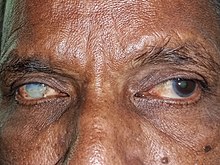| Corneal opacity | |
|---|---|
| Other names | Corneal scarring |
 | |
| Complete corneal opacity in right eye with normal left eye | |
| Specialty | Ophthalmology |
| Symptoms | Loss of vision |
| Complications | Blindness |
| Usual onset | Congenital or acquired |
| Treatment | Corneal transplantation |
| Frequency | 4th main cause of blindness globally (5.1%).[1] |
Corneal opacification is a term used when the human cornea loses its transparency. The term corneal opacity is used particularly for the loss of transparency of cornea due to scarring. Transparency of the cornea is dependent on the uniform diameter and the regular spacing and arrangement of the collagen fibrils within the stroma. Alterations in the spacing of collagen fibrils in a variety of conditions including corneal edema, scars, and macular corneal dystrophy is clinically manifested as corneal opacity.[2] The term corneal blindness is commonly used to describe blindness due to corneal opacity.
Keratoplasty also known as corneal transplantation is the main treatment option for visual improvement in corneal opacity. Other treatments which may improve visual outcome includes optical iridectomy, phototherapeutic keratectomy and keratoprosthesises. Corneal tattooing may be used for improving the cosmetic appearance of the opaque eye.
- ^ "WHO -Priority eye diseases". www.who.int. Archived from the original on March 22, 2006.
- ^ J Alroy , M Haskins, D E Birk (2001). "Altered Corneal Stromal Matrix Organization Is Associated With Mucopolysaccharidosis I, III and VI". Experimental Eye Research. 68 (5): 523–30. doi:10.1006/exer.1998.0622. PMID 10328965.
{{cite journal}}: CS1 maint: multiple names: authors list (link)